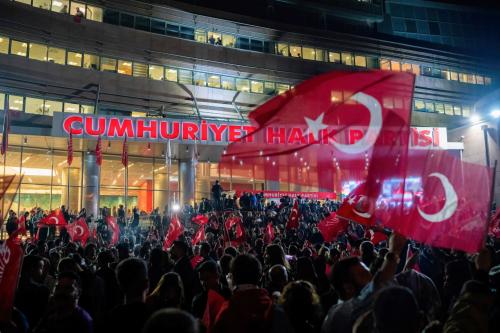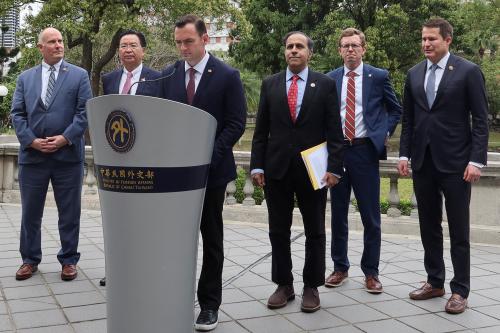The presidential election in Colombia last May 25 had a surprising outcome. Even though opinion polls forecasted the need for a second round and warned about both the stagnation experienced by President Juan Manuel Santos (who seeks a second consecutive term via reelection) and the recovery of Uribe’s follower Oscar Ivan Zuluaga, the surprising fact was not the win of Zuluaga over Santos, but rather the difference between the first and second places: 29.25 percent vs. 25.69 percent, a difference of almost 460,000 votes.
These results force a second round (on June 15) and both campaign teams have launched a process aimed at readjusting their strategies in order not only to preserve the hard-line vote they got in the first round but also to attract the citizens who voted for conservative Marta Lucia Ramirez (15.5 percent), leftist Clara Lopez (15.2 percent), for green candidate Enrique Penalosa (8.3 percent), for those who cast blank ballots (6 percent) or for the many who abstained.
Colombia, a country where voting is not mandatory and that historically registers low turnouts, again recorded in this election one of the highest abstention rates in the region (59.3 percent), the second highest in this country in two decades.
Alliances and Runoff Voting Issues
The launching of the campaign for the second round was underlined by the shaping of new alliances. Very rapidly (as was to be expected because of their ideological affinity), Zuluaga reached an arrangement with conservative Ramirez, who offered her support conditional on Uribe’s candidate moderating his opposition to the peace process.
Santos, for his part, has added support little by little, among it that of a good number of conservative legislators and of several leftist political leaders, who are together in the Frente Amplio por la Paz (Broad Front for Peace). However, he has not attained any express organic and en masse endorsement of the political forces led by Lopez and Penalosa. Both let their followers free to vote for whomever they choose (even though Lopez offered his individual support to Santos). However, it is foreseeable that a large number of those who supported these two candidates, if they decide to cast their votes in the second round, would do so for Santos.
The peace process with the FARC remains the central issue in this new stage of the campaign, as it becomes evident from the new positions Zuluaga and Santos have adopted in relation to this issue. The first one, as we have already pointed out and as a consequence of the pact with Ramirez, softened his firm-hand position regarding the FARC (which he had displayed during the first round) by saying: “We have agreed on the continuity of the talks with the FARC in Havana, with no secret agreements unknown to the people, with conditions and terms that guarantee tangible, definite progress, verifiable by international witnesses.”
Santos immediately reacted by declaring that Zuluaga’s turn was an “electioneering” ploy and warned that “peace is not improvised and neither is it done overnight” and that the process which offers the most guarantees is the one which his government currently develops in Havana. The President has placed at the core of the campaign the dilemma “the end of the war or the war without end”; and, in order to attract the largest possible number of voters, he pledged that, if he is reelected, as soon as peace is signed he will put an end to the obligatory military service.
Runoff Voting in Latin America and Colombia
Colombia is part of the majority group of Latin American countries (12 out of 18) which have a second-round mechanism in case that a winning candidate does not get an established number of votes (50 percent plus 1 in the case of Colombia).
The regional trend (since 1978 through now) shows that turnout usually decreases in second rounds, because a large part of the voters who cast their ballots in the first round do not feel attracted by neither of the two candidates staging the ballotage. However, there are exceptions in this regional trend. This phenomenon is usual when the second round is a very tight race and there is a chance for a “reversion of the outcome”; that is, that the winner in the first round loses in the second one, a situation that is likely in the Colombian case.
The Colombian experience regarding second rounds has its own particular features. Since its introduction in the 1991 constitution and to date, Colombia has held six presidential elections. In four of those six processes, a second ballot has been a must (1994, 1998, 2010, and 2014). And only Uribe, the third of the last four presidents since 1991, won in a first round (2002) and did likewise in his reelection (2006).
In two of these three ballotages (1994 and 1998), turnout increased for the second round, therefore going against the regional trend. And in one of these three second ballots, in 1998, there was a “reversion of the outcome”, when Andres Pastrana defeated Horacio Serpa.
Concluding Thoughts
As the ballotage nears, the campaign grows in intensity. Some last-minute event which might affect the final outcome cannot be discarded. On their part, the surveys carried out in recent days have failed to clear up the uncertainty regarding who will win the ballotage. While Cifras y Conceptos and Datexco give Santos larger vote intention, Ipsos-Napoleon Franco sees Zuluaga leading in opinion polls. Gallup records a technical tie. As we can see, all of these conditions point to a heart-stopping finale.
Given the tight difference and the difficulty that generally entails achieving a reversion of outcome, one of the possible scenarios would be the eventual defeat of the President. If that were the case, Santos would have the sad privilege of becoming the first chief executive in South America in failing to be reelected since 1978. It must be remembered that Alberto Fujimori attained his second reelection in 2000, even though that election was intensely questioned, brought about a political crisis and the untimely end of the Fujimori regime.
But the difficulties Santos faces to achieve a reversion of the outcome in the second round on June 15 should not be interpreted as an impossible mission. There are nine cases in the region (and, as we saw, one of them took place in Colombia) which bear witness to the fact that attaining that goal is difficult but not impossible.
In order for that to happen, Santos must be able to build a “negative consensus” against Zuluaga; that means enlisting a majority of the voters to go against Uribe and his followers, by presenting Zuluaga and his mentor Uribe as a risky and extremist option both for the continuity of the peace process and for Colombia. In other words, the reelection of Santos depends, to a large extent, on being able to increase the turnout (for those who share his proposals but who abstained in the first round to cast their votes) and, simultaneously, to attract the largest possible support from the left and the green, not because these electors identify with him but because of the horror that brings them together against a possible return of Uribe’s group. It is these new voters who hold the power to reelect Santos or to send him home.
This piece was initially published in Spanish by Estrategia & Negocios.


Commentary
Op-edSantos and Zuluaga in Heart-Stopping Second Round
June 6, 2014